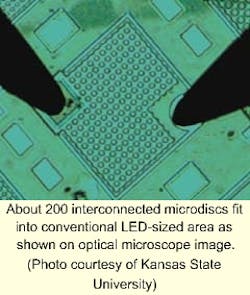Interconnected microdisc arrays outshine conventional LEDs
Researchers at Kansas State University have achieved a 60% increase in emission efficiency over a conventional 300 x 300-µm light-emitting diode (LED) by filling the same space with a two-dimensional array of interconnected microdisc LEDs, sized on the order of 10 µm in diameter.
At the fall 1999 meeting of the Materials Research Society (Boston, MA), the same team reported on individual microdisc LEDs fabricated from single indium gallium nitride/gallium nitride (InGaN/GaN) quantum wells grown using low-pressure metal organic chemical vapor deposition (see Laser Focus World, January 2000, p. 9). In the ensuing year, the researchers have focused on developing an interconnection scheme for the microdiscs (see image).
"At that time, we made only a 1 x 1 [microdisc LED] but we couldn't figure out how to connect them together," said Jingyu Lin, a member of the research team. "So we probed them individually."
The devices were successfully aligned and connected by standardizing a microdisc size and the spacing between them, which left enough room for contacts without compromising the tight microstructure of the interconnected device, according to team leader Hongxing Jiang. "We figured out that it would work very well if we left 2 µm [spacing] for the metal contact to each LED," he said.
The researchers attributed the improvement in quantum efficiency of individual microdiscs over conventionally sized LEDs to a combination of improvements in internal quantum efficiency and extraction efficiency. Internal quantum efficiency improves as a result of the higher combination rate between electrons and holes in the smaller space. Extraction efficiency improves because of the reduction in total internal reflection across the smaller LED-air interface, Jiang said.
The researchers have applied for a patent for the interconnected microdisc concept, which at time of writing was slated for publication in November.1 The team expects this capability for interconnection to transform microdisc LEDs from physics laboratory curiosities into practical and marketable components. In fact, they also expect the manufacturing efficiency of interconnected microdiscs to rival that of conventional LEDs.
"It came as a surprise that the number of steps was the same as for conventional 300 x 300 µm GaN blue LEDs. So if we use this method for mass production, total yield should be comparable with what other people are [already] achieving," said Lin.
In terms of performance, the researchers achieved output powers of 220 and 315 µW for 9-µm-diameter and 12-µm-diameter microdisc arrays, respectively, compared to 160 µW for a conventional broad-area LED. At 20-A input current, the forward bias voltage was increased slightly (4.1 and 4.4 V for 9- and 12-µm-diameter microdisc arrays, respectively), compared to a conventional LED due to smaller total active area and p-contact area on microdiscs. Yet the electroluminescence spectra shapes of the two device types remained similar, and the interconnected microdiscs produced more output light under all experimental conditions, even though the microdisc arrays have about one-third less total active area.
Possible applications of the interconnected GaN microdiscs include generating efficient blue-ultraviolet photons for producing white light through phosphor coatings, according to the researchers. The team believes that the interconnection method has the potential to improve brightness in other semiconductor LEDs as well as polymer and organic LEDs.
Currently, the research focus is on improving the existing design. "If we do more experiments, we can find the best combination of microdisc size and distance between microdiscs, as well as ways to optimize individual contacts," Jiang said.
REFERENCE
- Accepted for publication, Appl. Phys. Lett. (Nov. 13, 2000).
About the Author
Hassaun A. Jones-Bey
Senior Editor and Freelance Writer
Hassaun A. Jones-Bey was a senior editor and then freelance writer for Laser Focus World.
